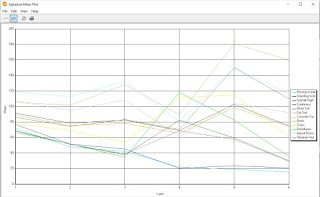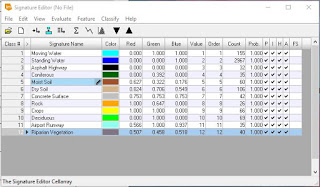Lab 8: Spectral Signature Analysis and Resource Monitoring
- Krista Emery

- Jul 31, 2019
- 3 min read
Updated: Apr 28, 2023
Goal
This lab is intended for familiarization with measuring and interpolating spectral signatures, or levels of spectral reflectance, based on imagery collected via satellite. These techniques can also be applied to monitor Earth resources through utilization of remote sensing band ratio techniques.
Background
Part one will introduce how to collect spectral signatures, graph their reflectance, and analyze the remotely sensed images based on the spectral separability test.
Part two will cover vegetation and soils analysis.
Methods
Part 1: Spectral Signature Analysis
We will be using Landsat ETM+ imagery to collect and analyze spectral signatures of Earth surface/near surface features of the Eau Claire and surrounding areas within Wisconsin and Minnesota.
Spectral channel (band) in micrometers in the order of highest reflectance and lowest reflectance for various surface types (screenshot figures seen below)
Signature 1: Standing Water 0.4 micrometers, 0.7 micrometers (figure 1)
Sig 2: Moving Water 0.5 micrometers, 0.7 micrometers (figure 2)
Sig 3: Deciduous Forest 0.6 micrometers, 0.7 micrometers (figure 3)
Sig 4: Evergreen/Coniferous Forest 0.6 micrometers, 0.7 micrometers (figure 4)
Sig 5: Riparian Vegetation 1.3 micrometers, 0.7 micrometers (figure 5)
Sig 6: Crops 0.5 micrometers 1.3 micrometers (figure 6)
Sig 7: Dry Soil 0.7 micrometers, 1.3 micrometers (figure 7)
Sig 8: Moist Soil 0.7 micrometers, 1.3 micrometers (figure 8)
Sig 9: Rock 1.3 micrometers, 0.7 micrometers (figure 9)
Sig 10: Asphalt Highway 0.4 micrometers, 1.3 micrometers (figure 10)
Sig 11: Airport Runway 0.7 micrometers, 1.3 micrometers (figure 11)
Sig 12: Concrete Surface 0.7 micrometers, 0.6 micrometers (figure 12)
Reasons behind signatures:
Absorptance of energy in calm water bodies increases as you get closer to the NIR band, so standing water would have the highest reflectance in the blue band (furthest visible energy from NIR), and lowest reflectance in the red band (closest to NIR of visible wavelengths.) Also, the blue band displays vegetation incorrectly. It needs to be lower than green band to show higher reflectance in blue due to atmospheric interference. (not corrected for atmospheric scattering)
Deciduous forests display the highest and lowest reflectance at the spectral channels of 0.7 and 0.6 micrometers, respectively. Deciduous forests (figure 3) have different leaf structures that reflect more energy than coniferous (figure 4) leaf structures. There is also a higher leaf area to stem-branch ratio in dorsiventral leaves compared to the needle-leafed conifer. Broad leaves reflect up to 10% more than needle-leaves.
The spectral channel that dry (figure 7) and moist (figure 8) soil vary the most within is the 0.6 micrometer channel, or the range between green and red channels. The difference is due to the change in soil moisture content between moist and dry soils. The drier a soil is, the more reflective it is. The more moisture a soil has, the less reflective it is. The channel that shows the most difference between the two soil types is the red channel. (figure 13)
Part 2: Resource Monitoring
Section 1: Vegetation Health Monitoring
We used band ratios to monitor health of vegetation and soils from remotely sensed images.
Through use of the unsupervised -> indices tool from the Raster Classification tab, we are able to single out areas with vegetation and without.
The presence or absence of vegetation in areas that are medium gray and black represents areas with little to no vegetation, and/or water features. Water has no reflectance in the NDVI (normalized difference vegetation index) image, thus it shows up as black. Medium gray shows healthy vegetation with more moisture. (Figure 15)
NDVI: NIR-Red/NIR+Red
Section 2: Soil Health Monitoring
Most of the ferrous minerals seem to be concentrated in the west and south west portions of Chippewa and Eau Claire counties. However, there are many plots throughout the two counties that show a dispersal of ferrous minerals amongst non-exposed soil and vegetated areas in the north and east of the study area. (Figure 16)
Ferrous Mineral: MIR/NIR
Results













Figure 14 All Spectral Signatures for Each of the 12 Surface Features and Key


Sources
Satellite image is from Earth Resources Observation and Science Center, United States Geological Survey.







Comments